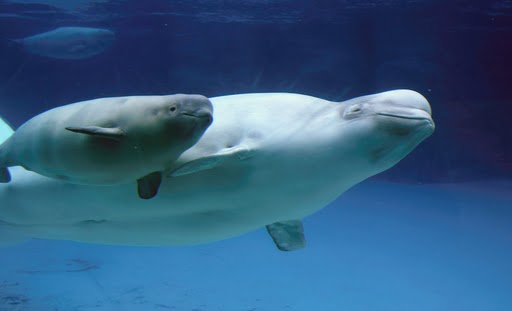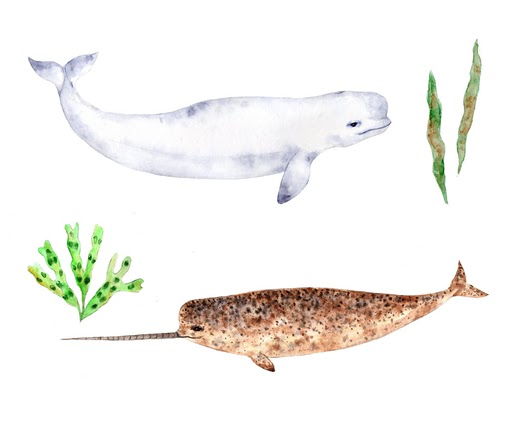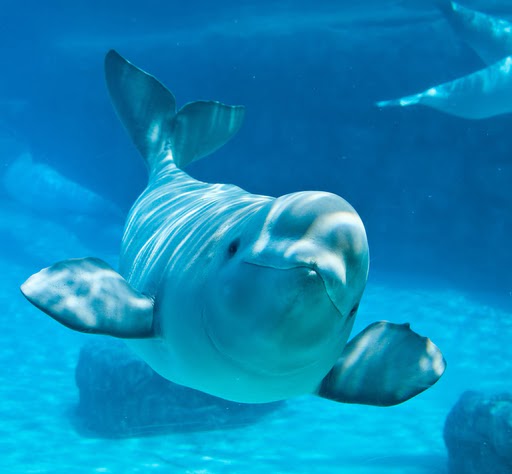White skin of beluga whales helps them blend in with the white icebergs and glaciers in the Arctic waters, providing protection against predators, especially polar bears.
If you enjoy whale watching, you might come across a magnificent 16-foot beluga whale, with its striking white color and melon-shaped head, reminiscent of the famous white sperm whale, Moby Dick, from Herman Melville’s novel. However, unlike Moby Dick, belugas are the only naturally occurring all-white whale species in the world, making them truly unique.
What’s In A Name?
The names of beluga whales, both common and scientific, are derived from their milky white skin. The word “beluga” is derived from the Russian word “beloya”, meaning white, while the species name “leucas” also means white in Greek.
 Moby Dick, the fictional white sperm whale (Photo Credit : rodos studio FERHAT CINAR/Shutterstock)
Moby Dick, the fictional white sperm whale (Photo Credit : rodos studio FERHAT CINAR/Shutterstock)
The white color of beluga whales is a result of their adaptation to life in the Arctic. Apart from physical characteristics like a dorsal ridge instead of a fin, allowing them to navigate through ice sheets, and a thick layer of blubber for insulation, their white skin is believed to offer protection against predators, particularly polar bears.
Sometimes, belugas can become trapped in cracks in ice sheets or glaciers. Each time they come up to breathe, they are vulnerable to attacks from polar bears, who can even prey on an entire group of whales. While belugas may not always win these battles, blending in with the white surroundings of the northern seas is their best chance of survival.
 Cracks in ice sheets become hunting grounds for polar bears (Photo Credit : FloridaStock/Shutterstock)
Cracks in ice sheets become hunting grounds for polar bears (Photo Credit : FloridaStock/Shutterstock)
White Skin… Blessing Or Curse?
Despite some of the benefits, the pale skin of belugas doesn’t always help them.
In addition to natural predators and human pollution causing their populations to decrease, these whales were also highly sought after during recreational and commercial hunts in the past. Luckily, such activities are now prohibited and belugas are protected under the Marine Mammal Protection Act. However, belugas are still used for crafts, clothing, and food by Alaskan Inupiat natives, who are allowed to capture them under specific regulations. In other words, the natives hunt belugas to sustain themselves.
 First people of Alaska (Photo Credit: Ric Jacyno/Shutterstock)
First people of Alaska (Photo Credit: Ric Jacyno/Shutterstock)
Are All Members Of A Beluga Pod White?
Not exactly.
Baby belugas look somewhat different from their parents. When they are born, the calves have a creamy-grey color. Within a month, this shade changes to a dark grey. Belugas usually give birth in shallower waters to protect their calves from predators that may be present in the open ocean.
The bodies of belugas also acquire a yellowish tint during their spring migration, which is shed off as a layer of degenerative skin, known as the “cork layer,” during their annual molt in the summer. This “cork” is a unique adaptation of the monodontidae family. It forms a protective barrier that prevents the skin of belugas and narwhals from getting damaged by ice.
 Beluga female with its calf (Photo Credit: CampCrazy Photography/Shutterstock)
Beluga female with its calf (Photo Credit: CampCrazy Photography/Shutterstock)
Aside from their color, what other notable features do Belugas possess?
Belugas are sociable and friendly creatures, often engaging in communication with each other using a unique language consisting of clicks, whistles, and moos. Their intricate and bird-like chirpy communication has earned them the nickname “canaries of the sea.” In addition to their intelligence, belugas have the remarkable ability to mimic sounds they hear, with some scientists suggesting they can even imitate human speech.
Belugas also possess distinct physical characteristics that distinguish them from other cetaceans. They have flexible necks, a feature uncommon among most cetaceans. Unlike other species, the neck vertebrae of belugas are not fused, allowing them to move their heads in various directions. Additionally, they have a special pair of muscles, similar to what humans refer to as “love handles,” which are rare in other whale species. These muscles, called pyramidalis abdominis, enable belugas to maneuver their bodies underwater with expertise.

The belugas, also known as the “canaries of the sea,” and the narwhals, often called the “unicorns of the sea,” are closely related.
As the only two members of the Monodontidae family, belugas and narwhals share many similarities, except for their coloration. However, one noticeable difference between them is the long horn-like tusk protruding from the narwhal’s forehead, which is actually its canine tooth. This distinctive feature gives narwhals the title of “unicorn of the sea.” Belugas, on the other hand, lack this horn and instead have a melon-shaped bump in front of their blowhole, which aids in echolocation, communication, and facial expressions.
In conclusion

Belugas are the only naturally white cetaceans in existence today, and with their round heads and plump bodies, they may also be considered the cutest. Their white skin serves as an adaptation that allows them to thrive in the frigid waters of the Arctic, providing them with camouflage to evade predators.
